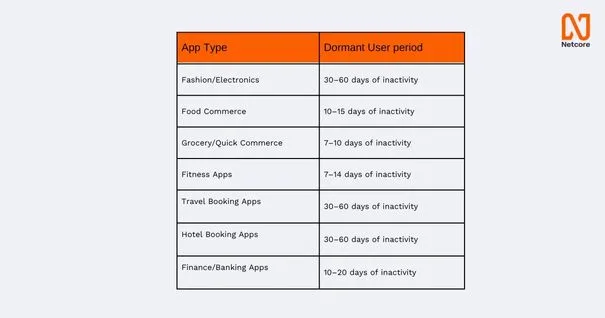What Are Dormant Users?
App engagement continues to be a major challenge for mobile marketers especially in the ecommerce space. According to projections from AppsFlyer, global app install advertising spending is expected to reach approximately $94.9 billion by 2025. With billions being invested to drive app installs, marketers naturally expect to see at least a 3x return on their customer acquisition efforts.
That’s exactly why dormant users have become a top concern for growth and marketing teams.
A dormant user is someone who was once active on your app but has remained completely inactive for a significant period of time. However, the inactivity window that qualifies a user as dormant can vary by industry.
For example:
- In a fitness app, a user may be considered dormant after just a week of no activity.
- In a food commerce app such as food delivery, quick commerce, or grocery delivery—a user might be considered dormant after only 15-30 days of inactivity.
Understanding and identifying dormant users is critical for designing effective re-engagement strategies and maximizing customer lifetime value (LTV).
Dormant users aren’t just inactive they’re missed revenue waiting to be reactivated. Every dormant user represents a sunk customer acquisition cost (CAC) with zero return if they don’t engage again. That’s lost revenue not just from a single transaction, but from their entire potential lifetime value (LTV).
What makes this even more critical is that dormant users were once engaged — meaning they’ve already shown intent, explored your offerings, and likely converted before. Reactivating them is often cheaper and faster than acquiring a new user from scratch.
In contrast, a well-crafted re-engagement strategy can turn dormant users into loyal repeat customers, improving both revenue and retention with minimal incremental investment.
Why Do Users Become Dormant?
You can identify dormant users by monitoring their behavioral activity which requires a data-driven approach going beyond tracking app open rates. Will explain how to track dormant users ahead in the blog, before that let’s understand the reason why their activity vanished from the app.
Common Reasons Why Users Become Dormant
Understanding why users lose interest is the first step toward building an effective re-engagement strategy. Here are some of the most common reasons users go dormant on ecommerce and food commerce apps:
1. Poor Onboarding Experience
If users don’t immediately understand the app’s value or how to use it effectively, they’re less likely to return after the first visit.
2. Lack of Personalization
Generic content, product recommendations, or promotions that don’t align with user preferences can lead to disengagement.
3. Irrelevant or Excessive Notifications
Too many push notifications or the wrong kind can irritate users, causing them to ignore or mute your app altogether.
4. Pricing Fatigue or Lack of Incentives
Users may lose interest if they don’t see fresh deals, discounts, or loyalty rewards that match their expectations.
5. Better Alternatives from Competitors
If users find faster delivery, better product variety, or more appealing offers on a competitor’s app, they may abandon yours.
6. App Performance Issues
Slow loading, bugs, crashes, or a clunky checkout experience can frustrate users and lead to drop-off.
7. Change in User Needs
Sometimes, users simply no longer need your service (e.g., diet changes, moving to a new city, budget constraints), and their inactivity has less to do with your app’s value.
Key Metrics That Define Dormant Users
Now that we’ve identified the key reasons why users become dormant, let’s take a closer look at how to define dormancy timelines based on industry type. Setting time-based rules helps create clear, consistent criteria for identifying dormant users within your system.
Here’s a breakdown of typical dormancy thresholds by business category:

1. Browsing Drop-Off Analysis
Focus: Users who browse products but don’t take any next step (e.g., add to cart).
How to analyze:
- Track product/category page views vs product click-throughs.
- Measure scroll depth and time spent on pages.
- Identify exit points (which product/category/page leads to drop-offs).
- Analyze search behavior – no results or irrelevant results often cause exits.
Key metrics:
- Product View to Add-to-Cart Ratio
- Session Duration
- Bounce Rate
- Exit Page Path
Tools to use: Google Analytics 4 (GA4), Mixpanel, Hotjar (for heatmaps), Amplitude, and Netcore’s segmentation.

2. Cart Abandonment Analysis
Focus: Users who add items to the cart but don’t complete checkout.
How to analyze:
- Track cart additions vs checkout starts and completions.
- Segment by product type, discount presence, and payment method selected.
- Identify friction points in checkout flow: login, payment, shipping, or coupon issues.
- Monitor cart abandonment rates by user segment (new vs repeat).
Key metrics:
- Add-to-Cart Rate
- Checkout Initiation Rate
- Cart Abandonment Rate = (Carts – Completed Purchases) ÷ Carts
- Time to Abandonment (how long after adding to cart users drop off)
Tools to use: Shopify Analytics, GA4 Funnel Reports
3. Churn Analysis
Focus: Users who stop engaging entirely (no sessions, purchases, or activity over a defined time).
How to analyze:
- Define churn thresholds (e.g., no activity for 30+ days).
- Conduct cohort analysis: see which group dropped off after how many days.
- Identify the last touchpoint or last purchase before drop-off.
- Analyze churn by acquisition channel or device type.
- Compare churned vs retained users by behavior (session frequency, AOV, engagement).
Key metrics:
- Retention Rate (Day 7, 30, 60)
- Churn Rate = 1 – Retention Rate
- Time to Churn (average number of days a user stays active before dropping off)
- Repeat Purchase Rate
Tools to use: Firebase, Mixpanel, Amplitude, Netcore Behavioural Analytics or Braze.
Strategies to Re-engage And Retain Dormant Users
Once you have a deep understanding of how users interact on your app, roadblockers or conversion blockers, and why they churn. You can also take the traditional route of running in-app surveys to understand your users’ expectations and what’s bothering them directly. Below we have collated some creative reengagement campaign ideas for reducing user dormancy:
1. Personalized Email and Push Notification Campaigns
Open rates for personalized emails are typically 29% higher than non-personalized ones.
Use rich email templates and tools like Netcore’s Co-Marketer for personalizing the content and campaigns. Using segmentation can also help improve your engagement rate. So smartly segment users to identify the dormant users. Use rich push notifications with engaging messages using banner, sound, emojis, etc
2. Product Recommendations Based on Past Behavior
Personalized product recommendations based on past behavior can boost conversion rates by 20–50% and increase average order value by 10–30%. They drive 35% of ecommerce revenue and 4.5x higher purchase likelihood. Users also engage longer, viewing 60% more pages and spending 2x more time per session.
3. Reactivation Offers/Discounts:
Reactivation offers can lift app engagement by 30–60%, especially among dormant users. Targeted discounts boost conversion rates by 25–45% and help recover churned users quickly. These campaigns also enhance retention and brand recall. You send email with subject saying “We Miss You! Here’s 25% Off Just for You.”
4. Win-Back Loyalty Programs
Win-back loyalty programs can increase reactivation success by 35–50%, encouraging lapsed users to return with rewards or tiered benefits. They improve long-term retention by 20–30% and boost brand affinity. Make campaigns with messages like ‘We’re inviting you back with exclusive loyalty rewards, earn points, unlock perks, and enjoy VIP benefits. It’s our way of saying we miss you!’
5. Using WhatsApp or SMS for high-value dormant users:
WhatsApp and SMS outreach can drive 90–98% open rates with 3x higher response rates than email. Personalized nudges or offers via these channels can reactivate high-value users with 20–40% success rates, making them ideal for time-sensitive re-engagement.
Learn how BigBasket leveraged Netcore’s email marketing and AI engine to achieve a 159% uplift in engagement and reactivate 20% of dormant users.
Boost App Engagement & Reduce Dormant Users with Netcore
Using a retargeting platform like Netcore empowers you to re-engage users with hyper-personalized push notifications, emails, and in-app messages driven by real-time behavior. With smart segmentation and AI-powered journeys, you can win back dormant users, increase app sessions, and build lasting user loyalty.
Ready to level up your engagement strategy? Book a free consultation with our App Engagement Expert today!
 Holiday Sales Are Won Now — Grab the 2025 Holiday Marketing Guide to Unlock More Revenue.
Holiday Sales Are Won Now — Grab the 2025 Holiday Marketing Guide to Unlock More Revenue. 












